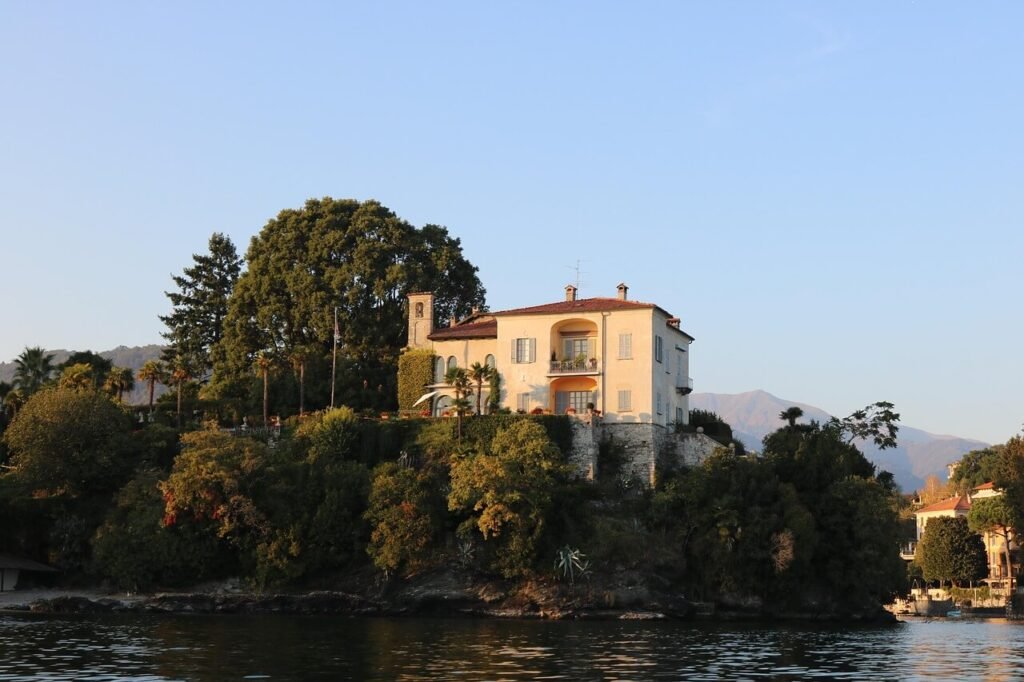Purchasing a villa on Lake Maggiore means far more than investing in square metres of architectural excellence. It means taking possession of a piece of that landscape which inspired Hemingway, Stendhal and generations of Grand Tour travellers.
For those wishing to buy a villa on Lake Maggiore, the journey requires specific knowledge extending beyond aesthetic intuition: legal, financial and practical aspects interweave in a complexity that can intimidate even experienced investors. This guide exists to accompany international buyers through every phase of the process, transforming a potentially labyrinthine decision into an informed journey towards the property of one’s dreams.
Lake Maggiore: Why Invest in This Destination
Lake Maggiore’s geographical position represents a competitive advantage difficult to replicate. One hour from Milan and thirty minutes from Switzerland, with Malpensa airport guaranteeing direct intercontinental connections, this destination combines international accessibility with secluded atmosphere.
The political and economic stability of Northern Italy reassures investors accustomed to evaluating country risk before committing significant capital. Luxury tourism has registered fifteen percent annual growth following the pandemic, fuelled by travellers seeking authentic destinations far from the overtourism afflicting other European destinations.
The luxury property market shows consistent appreciation of four to six percent annually, performance combining capital preservation with interesting returns. Yet what truly makes this territory special is quality of life: a mild climate allowing property enjoyment nine months yearly, a cultural offering surprising for modest demographic dimensions, security levels among Europe’s highest. Investing here is not speculation: it is a lifestyle choice supported by solid economic fundamentals.
Property Types Available: From Classic to Contemporary
Stresa Luxury Real Estate’s portfolio reflects the territory’s architectural richness. The Lake Maggiore villas for sale currently offered by the agency provide extraordinary variety to satisfy diverse architectural preferences and budgets. Period villas, built between the late eighteenth and early twentieth centuries, represent the most fascinating segment: historic buildings with original frescoes, coffered ceilings, marble staircases and that patina of time no restoration can replicate.
Properties such as the eighteenth-century villa in Lesa or Art Nouveau residences on Stresa’s hillside position themselves in the €2,100,000-€6,900,000 range, often including centuries-old parks and swimming pools.
Modern villas interpret luxury according to contemporary standards: minimalist architecture, large windows dissolving boundaries between interior and exterior, integrated home automation and elevated energy certifications. In Lesa, epicentre of contemporary construction on the lake, villas from €2,800,000 attract buyers privileging efficiency and current design. There exist prestigious restorations, historic properties requiring significant interventions yet offering total customisation margins: Baveno’s villa at €2,100,000 with 929 square metres represents this category.
The fundamental distinction separates lakefront properties from hillside ones: the former guarantee direct water access, private beaches and jetties, with consequent premium pricing; the latter offer breathtaking panoramic views and greater privacy, at prices averaging twenty to thirty percent lower.
Price Ranges and Opportunities for Every Budget
The market stratifies into three principal ranges, each with distinctive characteristics. In the €1,500,000-€2,000,000 range one finds renovated hillside villas or period properties requiring interventions: seven current properties fall here, representing the entry point to the lake’s luxury villa market. Examples include Verbania’s panoramic villa at €1,700,000 with 201 square metres or Agrate Conturbia’s nineteenth-century farmhouse at €1,950,000 on 2,100 square metres of land.
The €2,000,000-€5,000,000 segment concentrates thirteen properties and represents the market’s heart: completely restored period villas with park and pool, modern lakefront villas with highest-level finishes, historic residences in prestigious locations. Here lies the majority of transactions, where demand and supply meet with fluidity.
Beyond €5,000,000 begins exceptional territory: historic villas with unique characteristics, lakefront properties with extensive private beaches, residences redefining the luxury concept. Four properties declare prices in this range, peaking at €8,000,000 for a Stresa villa with commanding views of the Borromean Islands, whilst two properties maintain reserved pricing (POA).
The best opportunities hide in prestigious restorations: Baveno’s villa permits acquiring nearly one thousand square metres in a premium zone with contained budget, assuming complete restoration control according to one’s aesthetic preferences.
Legal Aspects for Non-Resident Buyers
Italian legislation permits foreign buyers to purchase property without significant restrictions, reciprocity principle aside for extra-EU citizens. Taxation articulates on three principal levels: registration tax at purchase (9% for second homes, reducible with certain structures), annual IMU calculated on revalued cadastral value, income taxes on rental income if the property is let.
The inheritance question merits particular attention: Italy applies the succession law of the deceased’s country of citizenship, but coordination between different legal systems can generate complications. A will drafted according to Italian laws with local notary assistance prevents future disputes. Specialised fiscal consultancy in cross-border transactions is not optional: tax implications vary drastically according to buyer’s country of residence, chosen ownership structure and villa’s intended use. Relying on professionals who simultaneously know Italian and origin country tax systems transforms potential traps into legitimate optimisation strategies.
Financing and Investment Financial Aspects
Mortgages for non-resident buyers are available through Italian and international banks, with loan-to-value typically between fifty and sixty percent. Italian banks require consistent income documentation: tax returns from the last three years, payslips or company balance sheets for entrepreneurs, supplementary asset guarantees.
The evaluation process requires an average sixty to ninety days, a period to consider in temporal planning. Alternatives include financing in the buyer’s origin country, potentially mortgaging other properties, a solution accelerating timescales and simplifying documentation yet potentially involving slightly higher rates.
Many international investors opt for cash purchases, eliminating uncertainties linked to credit approval and strengthening negotiating power with sellers. Accessory costs settle around ten to fifteen percent of price: registration tax or VAT, notarial fees (one to two percent), estate agency commission (typically three percent plus VAT), technical and surveying assessments, legal expenses for contractual consultancy.
Preventive fiscal planning optimises overall tax burden: choosing between personal or corporate purchase, evaluating fiscal convenience between exclusive use or partial letting, correctly structuring ownership with succession perspective. Every decision has long-term implications meriting thorough analysis before signing.
Due Diligence: What to Verify Before Purchase
Due diligence represents the phase separating serene purchases from potential bureaucratic nightmares. Cadastral checks verify correspondence between deposited plans and property’s actual state: even minor discrepancies can block deeds or generate future penalties.
Lake Maggiore falls within areas subject to stringent landscape constraints: any external intervention, from painting to terrace refurbishment, requires specific authorisations potentially requiring months. Verifying the existence of monument or environmental constraints prevents surprises during future renovations. Building compliance ascertains all historic modifications are regularised: never-sanctioned abuses, even dating back decades, become the buyer’s responsibility and can require demolitions or onerous regularisations. Structural technical surveys identify hidden problems: infiltrations, settlements, consolidation necessities, obsolete systems requiring complete replacements. These intervention costs should be mentally subtracted from purchase price to evaluate real convenience.
Easements and rights of way constitute often-underestimated aspects: discovering after purchase that the access driveway crosses others’ property or that third parties have transit rights in the park can compromise residential serenity. A local professional team comprising surveyor, real estate-specialised lawyer and international taxation-expert accountant represents an investment amply repaying itself, transforming regulatory complexities into operational tranquillity.
Post-Purchase Management: Maximising Return
Purchase marks the beginning, not the end, of the relationship with the property. Luxury rentals generate interesting returns: high-profile Lake Maggiore villas let between €5,000 and €15,000 weekly during high season, with occupancy rates of sixty to seventy percent for professionally managed properties. Property management relieves owners from daily burdens: coordinating routine and extraordinary maintenance, managing utilities, pre and post-guest cleaning, relationships with local craftsmen for necessary interventions.
Concierge services add perceived value to lettings: private chefs for exclusive dinners, boat rentals for exploring the lake, organising food and wine experiences, reservations at Michelin-starred restaurants. These extras justify premium pricing and create guest loyalty returning season after season. Fiscal optimisation continues post-purchase: the flat-rate tax regime on short-term rentals offers favourable taxation compared to ordinary income, whilst operational choices influence expense deductibility and overall taxable amount.
Exit strategy should be planned from the outset: the Lake Maggiore luxury market maintains good liquidity, with average selling times of six to twelve months for correctly priced properties. Capital appreciation, combined with rental returns and personal enjoyment, creates an overall return transcending simple financial performance, embracing that qualitative dimension making certain investments unforgettable.

Jared H. Furness loves sports! He writes about football, basketball, and baseball. He looks at player stats and tells fun, easy stories. His articles are very simple to read. Everyone can understand them! You can find his writing on big sports websites. He talks about how players play, exciting game moments, and smart plans. For example, he writes about games like Boston College Eagles vs. UVA and Arizona Diamondbacks vs. Miami Marlins. Jared writes his own stories, and they follow Google’s rules. They’re easy to find on Google and never copied. Fans and experts love his stories about stars like Bobby Witt Jr. and fun EuroLeague basketball moments. Jared makes sports writing super fun and clear!
